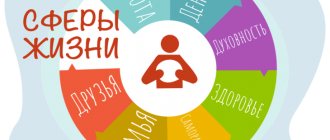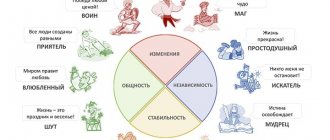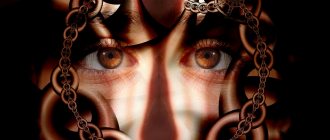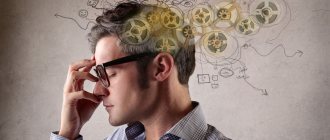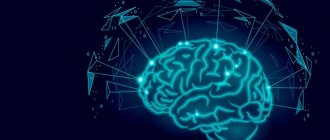Emotions are the most important component of higher mental activity, necessary for a person’s adaptation to life in society. The term “emotion” itself comes from the Latin word “emoneo”, which means “excitement” or “feeling”. This reflects the attitude of any person to the world around him and to himself. That is why disorders of the psycho-emotional sphere negatively affect a person’s entire life, interfere with the formation of stable interpersonal relationships, and interfere with full-fledged professional activity. At the Leto mental health center, doctors pay special attention to finding out the cause of disorders of emotional development and only after that they select the appropriate tactics of drug treatment and psychological correction.
Features of the formation of the emotional-volitional sphere
There are lower and higher emotions. The first include innate instincts, determined by the functioning of the subcortical region of the brain. They appear already in the first days of a baby’s life: for example, a child “signals” pain, hunger, and discomfort with loud crying.
Higher emotions are associated with certain spiritual needs (moral, cognitive and social). Their formation occurs as they grow older under the influence of various external circumstances: upbringing, society, etc. It is through communication with peers, parents and other people that the child experiences feelings such as love, hatred, affection, empathy, and fear. And the environment largely determines what emotions will prevail in the character.
In everyday life, a mentally healthy person experiences a variety of feelings that correspond to his state of health and situation. A long-lasting emotional state is called a mood. Short-term but very intense emotions that arise under the influence of circumstances that are significant for a particular person are called affect: grief, extreme delight, shame, bewilderment, etc.
The experience of affects has a huge impact on the perception of the world and the formation of a specific personality. That is why experts in the field of psychology and psychiatry consider experiencing a stressful situation as one of the main causes of psycho-emotional disorders. Affects significantly influence a person’s overall well-being. Strong feelings are accompanied by:
- increased blood pressure;
- increased heart rate and breathing;
- sweating;
- dilation or constriction of the pupils;
- paleness or redness of the skin.
But sometimes the state of passion does not pass without a trace, and the consequences of such strong experiences persist in the form of causeless anxiety, fear and internal tension - these feelings underlie most emotional and personal disorders.
Emotional and psychological disorders in childhood and adolescence
Behavior is a person’s ability to change his actions under the influence of internal and external factors; it is any reaction in response to an external stimulus, through which the individual adapts to the external environment. Human behavior is a set of actions that express his attitude towards society, other people, and the objective world. Behavior is a phenomenon characteristic not only of humans, but of any living creature, however, to this day, for psychological science, the study of the phenomenon of human behavior is in the first place. Behavior as a subject of study of psychology has come a long way: from the research of domestic physiologists I. M. Sechenov and I. P. Pavlov to modern research in the field of psychological science, and not only psychological science. At this stage, theories of behavior are increasingly appearing in marketing research, sociology, politics and, perhaps, probably in any science that in one way or another concerns man and society, from the classical teachings of reflexes to the study of complex forms of group interaction, and psychotherapy. Behavior has more than once been the subject of study of psychology, and no less often has researchers pushed it behind the scenes of psychological science and practice, but at this stage it is obvious that there is no such direction in the “science of the soul” (psychology) that in one way or another does not concern the phenomenon of behavior. The study of behavior is no less important for solving fundamental issues of developmental psychology and pedagogy. Developmental psychology (developmental psychology), as a discipline that studies psychological changes in a person as they grow older, like no other psychological discipline, appeals to childhood, studying the child’s psyche at all ages and at all stages, and studies behavior. Today, one of the central problems of developmental psychology is the problem of various behavioral disorders in childhood and adolescence and the study of the factors leading to these disorders. The prevalence of behavioral disorders of various origins in children today is quite high. According to various sources, figures range from 12% to 25% of the total child population. Such a wide range of quantitative indicators is primarily due to differences in the methods used by different researchers. But it has been reliably established that behavioral disorders are detected more often in boys than in girls (85% and 15%, respectively, according to various sources). Behavioral disorders can be expressed in different ways, for example, as deviations from social and moral norms accepted in a given society, as repeated persistent actions or behaviors, including mainly aggressiveness, asociality, and social passivity. Also, behavioral disorders include the disorders described in ICD 10 as “Emotional disorders and behavioral disorders beginning in childhood and adolescence” (ICD 10 F 90 - 98), but regardless of the origin of the disordered behavior, as a characteristic feature of all behavioral disorders One can distinguish disadaptation (disturbances in the adaptation mechanism) and not just violations of the adaptation mechanism, but increasing disadaptation. which has an unfavorable course may affect the entire sphere of social functioning of a teenager or child.
At the present stage of research, behavioral disorders in childhood and adolescence, due to their origin, can be divided into two broad groups:
1. Behavioral disorders that are caused by various kinds of psychological and social problems.
2. Behavioral disorders that are caused by mental and psychophysiological disorders (diseases), as well as various kinds of organic dysfunctions of the central nervous system in childhood.
The first group includes such common factors as: disorders of child-parent relationships, various types of disturbances in the process of upbringing in the family, characterological characteristics of the child, characteristics of the emotional-volitional sphere of the child, characteristics of the child’s personality, characteristics of puberty. What is characteristic in this case is that behavioral disorders do not have a “biological basis” and are usually caused by a number of “conflicts,” both interpersonal (most often intrafamily) and intrapersonal (dissociations).
In the group of psychogenic (due to psychological and social reasons) behavioral disorders, several natural directions of these disorders can be distinguished.
Unsocialized conduct disorder (ICD 10 F 91.1)
It is characterized by a combination of persistent conflict or aggressive behavior with a significant general disruption of the child’s relationships with other children and adults, often combined with mild emotional disorders. As a rule, a child cannot effectively integrate into a peer group; on this basis, it is important to differentiate this disorder from “socialized” behavioral disorders, which will be described below.
Socialized conduct disorder (ICD 10 F91.2)
Characterized by persistent conflict or aggressive behavior, including group delinquency (criminal behavior), in children and adolescents who are well integrated into the peer group. Emotional disturbances in this case are usually minimal. This group of behavioral disorders corresponds to the concept of non-pathological forms of deviant (deviating from accepted norms) behavior accepted in Russian psychiatry.
Oppositional defiant disorder (ICD 10 F91.3)
This type of behavior disorder is typical for children under 10 years of age. Determined by the presence of persistent negativistic, hostile, defiant, provocative behavior and the absence of more severe conflict or aggressive actions. Negativity is a normative feature of children's behavior, especially at the age of 1.5 - 2 years. It becomes pathological if it becomes stable as the child grows up. The disorder can be diagnosed after 3 years of age, but usually reverses but usually appears when the child enters school.
The second group includes such factors as: the presence of serious mental disorders in the child, borderline emotional disorders, complex interaction of the biological factor with residual organic cerebral insufficiency and social factors. It is worth noting that in this group of disorders, behavioral disorders act rather as a consequence, and require a particularly careful assessment of the influencing factors, because the adequacy of corrective measures, and in some cases, the possibility of drug treatment, largely depends on the correct assessment of these factors. According to various sources, the number of children with disorders of this origin is constantly growing. In the practice of a pedagogical psychologist, it is quite often possible to alleviate complaints from teachers and parents about the child’s restlessness, excessive disinhibition and excitability, and inattention in class. Often the consequence of these symptoms is poor academic performance and maladjustment. It is not uncommon for this category of children to be labeled as “C” students, chronically “underperforming”, “weak” students who “do not obey”. This category of children are often victims of “neglect” and misunderstanding on the part of parents and teachers. It is also worth noting that timely diagnostic and corrective work and further support can, to a certain extent, reduce the degree of consequences of this group of disorders, and often eliminate them.
The described disorders include a group of hyperkinetic disorders. (ICD 10. F90).
Attention impairment (ICD 10. F90.0)
One of the symptoms of hyperdynamic syndrome is impaired attention. The clinical picture of impaired attention manifests itself either in the form of a complete lack of focused attention, the inability to attract the child to the necessary activities, or appears as short-term (from 1 - 2 to 10 - 15 minutes) episodes, followed by an inability to concentrate attention, exhaustion and sharply increasing hyperkinetic manifestations.
Hyperkinetic behavior disorder (ICD 10.F90.1)
Hyperkinetic syndrome often manifests itself in the form of excessive mobility, fussiness, and excitability. The movements are sweeping, poorly coordinated and not purposeful, writing impairments are noted, and injuries are common among these children. The syndrome occurs between the ages of 1.5 and 15 years, and is most clearly manifested in preschool and primary school age.
It is especially worth noting adolescence. This period of development of a child’s personality, according to many authors, is a crisis period. During puberty, a “general” restructuring of the child’s personality occurs, a spontaneous transition from childhood self-awareness to inevitable adulthood. It is at the stage of the pubertal crisis (approximately 14-15 years) that those parts of the cerebral cortex that are responsible for various forms of behavior and self-regulation complete their formation. Today, deviant behavior is increasingly associated with adolescence. In adolescence, behavioral disorders are very common, and the causes of their origin are usually multifactorial in nature. Behavioral disorders are caused by the ambiguity and inconsistency of children's development at this age stage. At this age, all the features of the child’s mental sphere emerge most clearly and the results of parental upbringing appear.
Deviant (deviant) behavior is behavior in which deviations from social norms are persistently manifested. At the same time, deviations of the selfish, aggressive and social-passive types are distinguished. Social deviations of a selfish orientation include offenses and misdemeanors associated with the desire to illegally obtain material, monetary and property benefits (embezzlement, bribery, theft, fraud, etc. Social deviations of an aggressive orientation are manifested in actions directed against the individual (insults, hooliganism , beatings, rape, murder), social deviations of a selfish and aggressive type can be both verbal (insult with words) and non-verbal (physical pressure) Deviations of a social-passive nature are gaining great momentum. Most often, these deviations are expressed in the refusal of an active life positions, avoidance of work, study, persistent reluctance to solve personal and social problems. Socially passive deviations, in the form of drug, alcohol, and other substance use among adolescents, are epidemiological in nature [Zmanovskaya E.V. Current problems of deviantology].
It is known that the first social institution of society is the family, whose influence is the longest and most systemic. At the present stage of socio-economic development of our society, the role of the family and the relationship between the child and parents are becoming even more important than before. Unfortunately, in recent decades there has been a significant increase in single-parent families. In conditions of targeted moral education, the process of formation of social attitudes of the personality of a teenager or child takes on a spontaneous character. It is in the family that the child develops ideas about himself and society as a whole, methods of interpersonal interactions, and strategies for existing in the social environment, which he takes from the microenvironment to society in the process of socialization.
forensic expert TsSIiE,
special psychologist Kozlov Yu.A.
Main types of psycho-emotional disorders
There are the following forms of disorders:
- reduction in the intensity of sensory experiences;
- hypertrophied emotional and behavioral disorders;
- emotional and affective disorders.
Syndromes accompanied by deterioration of emotional sensitivity
This group of mental disorders includes:
- Apathy: indifference, indifference to certain events and impressions. Characteristic of depression, dementia and congenital mental retardation, organic lesions of the central nervous system, schizophrenia and epilepsy.
- Anhedonia: loss of the ability to experience joy in life and activities that previously brought pleasure. Noted in emotional disturbance syndromes such as depressive and neurotic disorders.
- Mental anesthesia, which is accompanied by the inability to experience either positive or negative emotions. At the same time, the person realizes that he is not able to feel sympathy, sadness, joy, love and experiences this very painfully. Such a violation of the emotional and personal sphere is typical of severe depression.
- Hypotymia, the main symptom of which is a constant depressed mood with feelings of despondency, hopelessness and melancholy.
- Ideational retardation. It manifests itself in a slower pace of thinking, a decrease in the speed of formation of logical associations and abstract images. Without treatment, this form of psycho-emotional state disorder turns into stupor with complete immobility.
The syndrome of psycho-emotional “dullness” is considered separately, in which the sensory reaction is clearly reduced and does not correspond to what is happening. The main manifestations of higher emotional activity gradually disappear - all further actions of the patient are “dictated” only by instincts. Similar symptoms occur in severe mental illnesses, in particular in schizophrenia and schizoaffective disorders, in the terminal stages of alcoholism and drug addiction.
For this kind of emotional-volitional disorders the following are typical:
- pessimistic thoughts;
- decreased self-esteem;
- doubts about one’s own professional suitability and moral character.
Patients consider themselves failures, unworthy, worthless people. The future has no prospects, everything is seen in a gloomy light, a person expects only unpleasant events - illness, career destruction, dismissal, impoverishment, etc. He cannot remember any pleasant events: only mistakes and failures come to mind.
Increasing the intensity of psycho-emotional reactions
Mental hyperesthesia is manifested by excessive experiences of any emotions, both positive and negative. Such symptoms often occur in the prodromal period of many mental disorders, in particular schizophrenia, hysteria, dissociative syndrome, with severe intoxication with alcohol and drugs, and organic lesions of the central nervous system.
Such disturbances in the psycho-emotional state are accompanied by a feeling of joy, bliss, delight and euphoria, and a sense of personal superiority. It is possible to develop delusions with ideas of greatness, invention, and religion. In severe cases, obsessive thoughts are accompanied by auditory hallucinations: a person hears voices that talk about his high destiny, call him a “messiah,” etc.
In some cases, a manic syndrome develops, accompanied by an acceleration of all thought processes. The patient talks incessantly, screams, is agitated, cannot sit in one place, and makes chaotic, aimless movements. He does not feel tired and is not able to be critical of his own condition.
Emotional and behavioral disorders
The most common manifestation of the syndrome is phobic disorders. The main symptom of this pathology is a very strong, irrational fear of a certain object or situation. This group of diseases includes isolated phobias (fear of animals, insects, heights, etc.) and more complex disorders of emotional control: fear of open spaces and crowded places (agoraphobia), speaking in public and condemnation from others (social phobia).
general characteristics
Emotions are mental states that reflect a person’s attitude to current events, to people and to himself.
Emotional reactions consist of three components: a feeling of experience, changes in physiological processes and the appearance of external expressive complexes. In other words, a person feels an emotion (joy, anger, fear, sadness), experiences changes in the functioning of the body (sweating, heartbeat) and expresses his state with the help of facial expressions and gestures. Emotional states become pathological when their duration, intensity and content do not correspond to the situation and bring physical and psychological discomfort. Psycho-emotional disorders are characterized by unreasonable and inadequate affect, do not fit into the usual time frame, interfere with the performance of social functions, are perceived as painful or are not recognized by the person himself.
Cost of services
| CONSULTATIONS OF SPECIALISTS | |
| Initial consultation with a psychiatrist (60 min.) | 6,000 rub. |
| Repeated consultation | 5,000 rub. |
| Consultation with a psychiatrist-narcologist (60 min.) | 5,000 rub. |
| Consultation with a psychologist | 3,500 rub. |
| Consultation with Gromova E.V. (50 minutes) | 12,000 rub. |
| PSYCHOTHERAPY | |
| Psychotherapy (session) | 7,000 rub. |
| Psychotherapy (5 sessions) | 30,000 rub. |
| Psychotherapy (10 sessions) | 60,000 rub. |
| Group psychotherapy (3-7 people) | 3,500 rub. |
| Psychotherapy session with E.V. Gromova (50 minutes) | 12,000 rub. |
This list does not contain all prices for services provided by our clinic. The full price list can be found on the “Prices” , or by calling: 8(969)060-93-93. Initial consultation is FREE!
Features of diagnosis and treatment
The severity of disturbances in the emotional and personal sphere is determined using a special psychological testing system. Analysis of the answers to the questionnaire allows the doctor to assess whether the patient is aware of the changes happening to him, whether he understands the need to start therapy, and to create a general description of his personality.
The treatment tactics for psychoemotional disorders depend on the clinical picture. For severe depressive syndrome, hypothymia and apathy, antidepressants, anxiolytics and thymoleptics are indicated. In case of manic syndrome, sedatives are prescribed; in severe cases, the problem can only be solved in a clinical setting - hospitalization and the use of antipsychotics under round-the-clock medical supervision are necessary.
If symptoms of psycho-emotional disorders appear, it is better not to engage in self-diagnosis and self-medication, but to consult a specialized specialist as soon as possible. To make an appointment or call a doctor at home, contact our operators on a 24-hour anonymous phone number 8(969)060-93-93.
Classification
Emotional disorders can be independent disorders or components of other mental illnesses. Pathological intensification of emotions is manifested by an increase in their intensity while maintaining adequate content. This group of disorders includes:
- Depression.
The structure of depressive states is dominated by low mood and depression. Patients feel anxiety and a feeling of inferiority. They perceive everyday difficulties as insurmountable and provoke crying, despondency, and reluctance to do anything. - Mania.
Manic states are manifested by elevated mood, accelerated rate of mental activity, and increased physical activity. A person becomes hyperactive, fussy, strives for achievements, to learn new things, but he lacks concentration and focus. - Euphoria.
In euphoria, people are dominated by carelessness, elevated mood, and infantility. Critical abilities and serious attitude to situations decrease. Passivity and excessive complacency do not allow you to perform daily duties.
Another option for psycho-emotional disorders is weakening of emotions. Regardless of the events taking place - joyful, sad, provoking aggression - people remain indifferent or experience weak feelings that do not correspond to the significance of the situation. Examples of such disorders:
- Emotional flattening.
With some mental illnesses, for example, with schizophrenia, emotions become impoverished - they become monotonous, primitive, and weakly expressed. In severe cases, only some manifestation of dissatisfaction in situations of discomfort remains. Other events - meetings with relatives, the loss of a loved one - do not evoke any emotions. - Apathy.
A state of apathy is typical for patients with depression. There is a general decrease in all emotional reactions. The patient is indifferent to what is happening, unable to experience joy, sadness, fear, anger. Often apathy is combined with a decrease in motor activity and abulia - pathological lack of will, the inability to begin any action.
When the mobility of emotions is impaired, a person’s ability to control the duration of the experience changes. This is manifested by stuckness, suddenness, or rapid uncontrollable changes in emotional states. There are several variants of the dynamic aspect disorder:
- Emotional lability.
With affective lability, emotions arise easily, quickly replace each other, and depend on fleeting external events or random memories. Such conditions are considered normal in early childhood, when a child’s tears suddenly give way to laughter, but in adults they are a sign of emotional disturbance. - Explosiveness.
This term refers to emotional explosiveness. After a period of calm, a person suddenly demonstrates anger, irritation, anger, and then just as quickly returns to a state of balance. During explosive outbreaks, aggression and provocation of conflicts are possible. - Inertia.
Synonyms for inertia are stuckness, stiffness. Such people experience one emotion for a long time, cannot be distracted and change it at will, and are in a state of irritability, melancholy, and anger.
The most striking psycho-emotional disorders are disturbances of adequacy. Inappropriate emotional manifestations are classified as pathological according to the content criterion: what a person feels has no connection with his thoughts or external events. This group includes:
- Inadequacy.
With emotional inadequacy, a person experiences and demonstrates emotions that are completely inappropriate for the situation. For example, laughter occurs in response to the news of the death of people, outbursts of anger when meeting a loved one (mother, friend). - Ambivalence.
People with schizophrenia often experience ambivalence of experiences - the simultaneous existence of opposing emotions. This condition is difficult for a healthy person to understand. Outwardly, it manifests itself as a constant, unconditional change of joy and melancholy, tenderness and anger, anger and tearful weakness. - Emotional tension.
Inappropriate experiences may include pointless fear, unmotivated anxiety, an inexplicable feeling of anger or dissatisfaction with oneself. In such conditions, people are in emotional tension, but cannot determine what is causing it. Usually they say: “the soul is restless”, “suddenly the soul is in

